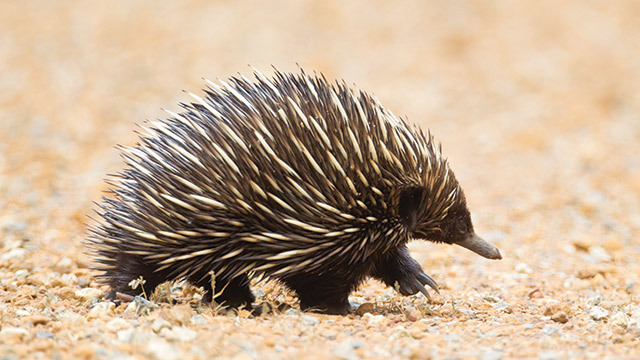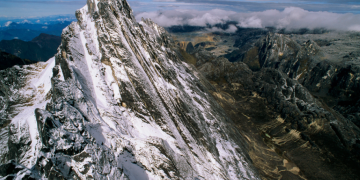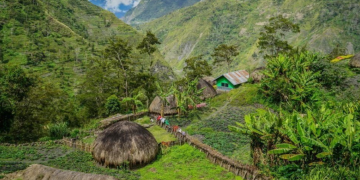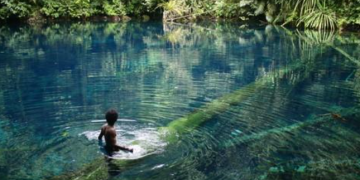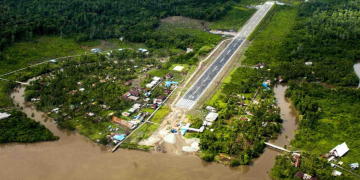PAPUAAROUND – Did you know that Indonesia has mammals that lay eggs? Are there animals like the Platypus in Indonesia? The answer is there.
The short-beaked echidna is a mammal from the monotreme (egg-laying mammal) family. This animal is a primitive mammal that still reproduces by laying eggs (ovivovivipar). Incubate their young, as mammals usually do.
In Indonesia, this animal only exists in Jayapura Regency, more precisely at the foot of Mount Cyclops. Echidna is also known as Nokdiak.
In its place of origin, people respect this animal as a king. Residents of Ormu Wari Village, Raveni Rara District, Jayapura Regency, at the foot of Mount Cyclops, consider this animal sacred.
Morphology
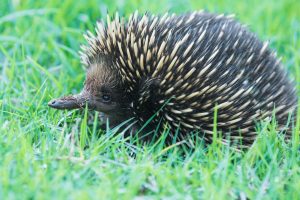
The echidna or Nokdiak is a native Papua egg-laying mammal similar to a mini hedgehog.
The echidna or Nokdiak is a native Papua egg-laying mammal similar to a mini hedgehog.
At first glance, this animal looks like a small hedgehog, because the spines cover most of its body. The spines on their bodies are the true evolutionary form of hair in mammals. The length of the spines starts from 50 mm with several different colors, brown, reddish brown to black.
The short-beaked echidna has the Latin name Tachyglossus aculeatus . This is reflected in its characteristics, namely tachyglossus which means fast tongue and aculeatus which means equipped with thorns.
Thorns do not cover the face, legs and hands. In that section there is only reddish brown hair. Because the face of this animal is very cute, the mouth of the Nokdiak can’t open more than 5 mm, and its diameter is only 9 mm.
Nokdiak is not big, if it measures 30-45 cm, it only weighs about 2-7 kg. But the Echidna has a long muzzle, about 75 mm in the shape of the cheeks. In addition, the short-beaked echidna has a relative, the long-beaked echidna.
On the hind legs, Nokdiak’s curved claws help them dig. Besides that, it can also help protect themselves from danger because they can dig from under the ground.
Reproduction and Behavior
For reproduction, these animals mate from mid-May to early September. Male echidnas actively seek females to mate with. They formed a line called the “Nokdiak Train”. The female leads the “train”, then ten males follow her. Even the younger males are often in the back row.
A month after mating, the female places soft shell eggs in her pouch. The gestation period is quite fast. Nokdiak babies hatch within 10 days.
Nokdiak babies are often referred to as “Puggles”. They live in nests built by their parents for up to a year before they are able to make their own.
Habitat and Feed
Nokdiak likes to live in scrub, desert, and mountain forests. Digging for food and shelter is the key to his life.
The nostrils at the end of its beak allow the Nokdiak to sniff out the next piece of food. The rubbery muzzle is also sensitive to electrical signals from the insect’s body. Strong enough to open hollow logs and plow through forest floors in search of insects.
Nokdiak is a mammal that does not have teeth like pangolins. But Nokdiak can use their long sticky tongue. Movement of the tongue is very fast. This allows them to quickly hunt ants, worms and insect larvae.
Threats and Protection
Extensive poaching in the state of Papua remains the biggest threat to the Nokdiak in its natural habitat. Many people hunt to make Nokdiak food. According to local residents, Nokdiak’s meat also tastes sweet and is in great demand, which is why hunting is still being carried out today.
This makes the Nokdiak one of the protected animals according to the Decree of the Minister of Environment and Forestry (P.106/MENLHK/SETJEN/KUM.1/8/2018).
Nokdiak or Echidna is an animal protected by the government. According to the Red List of The International Union for Conservation of Nature (IUCN), this animal is included in the category of animals with least concern.
So, that’s a little explanation about the Nokdiak animal or the echidna, the egg-laying mammal from Papua. Let’s preserve this rare animal so it doesn’t become extinct. Hopefully useful ^^

